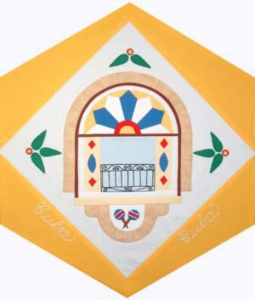Cuba

The Block
This block is a window into block-maker Ana Warren’s memories of growing up in Cuba. A multi-coloured, fan-shaped design crowns the window, reminiscent of the medios puntos (stained glass) typically found on Cuban buildings. This tradition of stained glass, influenced by Europeans, gave the architecture its specific character, and served a dual purpose. It provided colour and ornamentation to the houses, and, when added over doorways, it allowed light to enter when drapes were drawn to keep out the hot sun. The curlicue fencing represents the block-maker’s fond memory of playing with her sister on the balcony. Decorative wrought iron work is commonly used on Cuban balconies as a form of creative expression. The maracas below the window symbolize the huge part music plays in Cuban culture.
Cultural Profile
Cuba, the world’s largest exporter of sugar, is made up of mountains and plains. It has more than 200 rivers, of which only two are navigable. It is home to an amazing variety of tropical fruits and flowers (over 3,000 varieties) and nearly 300 species of birds. Cuba derives its name from the Taino (early inhabitants) word cubanaćan, meaning a centre or central place.
Little evidence remains of Cuba’s first indigenous people, the Ciboney and the Tainos. Currently the population is made up of mulatto, white, black and Chinese people. The official language is Spanish although English is widely spoken. Among family and close friends, Cubans speak informally, but as a sign of respect when meeting someone new, or when talking to the elderly, they speak in a more formal manner. Nicknames such as mi amor (my love), mi corazòn (my heart) and mi vida (my life) are frequently used, even between strangers. Cubans are avid sports enthusiasts, especially for pelota (baseball). They have close-knit families and are sincerely friendly to visitors to their country.
‘Sweet fifteen’ is an important Cuban tradition — a rite of passage in the life of Cuban girls marking their entry into adulthood and accompanied with lavish ball gowns and professional photoshoots. The guayabera, a shirt of cotton or linen with four pockets sewn on the front and two pleats on the front and back, is the official national dress for both men and women.
The country is known for its rich and varied music, a blend of Spanish and African rhythms and melodies that have inspired dances such as the danzόn and chachachá, and the folk-jazz style of music known as son. The Cuban tres, a guitar with three pairs of strings, takes center stage in Cuban music, along with percussion.
Cubans are also famous for their fine cigars, which are produced from the country’s second-most valuable crop, tobacco, their rum, made from the sugar cane widely available on the island, and fine coffee. Cuban arts and crafts include embroidery, straw weaving, wood and horn carving, pottery, and seashell art.
A distinctive sight on the streets of Cuba is the parade of classic American cars of the 50s, maintained by the ingenuity of their owners as, since the 1960s, there has been an embargo on importation of car parts and new cars from the United States.
Immigration records indicate that Cubans have been coming to Canada since 1974 to seek a better life for their families, to pursue their education or to look for employment opportunities. It is estimated that there are now approximately 21,000 Cubans in Canada.
Sponsor: Patricia and Rose Sisty
